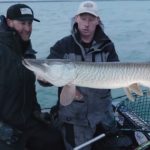Run-and-Gun Muskie Fishing
There are many schools of thought on which is the best route to muskie fishing success. On the subject of pace-slow versus fast-some folks tell us that we should fish every spot thoroughly in order to pry a wary muskie out of its sanctuary deep in the weeds or back in the shadows. Fishing this way is slow. It’s a grind. In a day of fishing, you may fish 15-20 spots. Others tell us that slow is nonsense. Fish fast, they say. Cover water. Hit 50 spots instead of 20, and you will bump into more muskies in a day. This is run-and-gun muskie fishing.
So who is right? Having chased muskies for over 30 years, I have earned the right to say that I have no clue. But if I were forced to make a call, I’d say neither is right. Certainly not in all situations-not under all conditions.
Both groups can claim impressive results. Anglers who put in serious, intelligent time on good water, whether they fish slowly and thoroughly or run-and-gun, can point to numbers that support their style.
The fact is that some conditions-for example, a massively complex spot with abundant cover, heavy weeds, and assorted nooks and crannies-will require that you slow down and thoroughly probe every possible angle. On the other hand, when muskies are known to be using acres of sprawling featureless flats, in gin clear water, you can kick the trolling motor up to 3/4 speed and move right along-fan-casting acre after acre. When you can see a muskie charging in from 50 feet off to the side to intercept your bucktail, there is no need to space your casts 2 feet apart. It’s a situational thing.
There is another situational consideration-one that has more to do with human nature. During the course of a 12 – 16-hour fishing day, you will spend time on spots that have a significant history. You may have caught several muskies over the years on one particular spot. You may have lost a fish of a lifetime on another spot. It’s not a matter of someone telling you it’s a good spot. It’s personal. You have personal history on the spot. The angler in the back of my boat always knows when we are fishing a personal history spot. The tone of my trolling motor drops from a high whine to a slow whump … whump … whump … and the spacing of my casts drops from feet to inches. I don’t have to say: “Concentrate. This is a good spot.” My fishing pace gives it away.
Conversely, there are the new spots … the long, endless shorelines we’ve never fished before … We’re looking as much for a clump of weeds or a few boulders as much as we’re looking for a follow. We’re exploring, and we’re looking for new spots. It’s classic run-and-gun time. Sure, the more thorough anglers would argue that by slowing down, we’d have a better shot at actually catching a fish. But part of every day I fish is set aside for exploring, for learning new water. The more water I cover, the more I learn. I think it pays off in the long run.
 Run-and-Gun Tools
Run-and-Gun Tools
This time, we’ll look at the run-and-gun style, and the equipment that makes it work. Sometime down the road we can look at the best tools for slower, more methodical fishing.
The most important tools for rapidly covering water are rods, reels, and lures that make it easy to cast and retrieve quickly, hour after hour. We are not probing down into the depths; we are fishing high and fast, so shallow running lures are fine.
The ultimate high-speed burning bait is an in-line bucktail. For about 30 years, the Windels Harasser has been the standard. In more recent years, smaller “French” blades have become popular. (The “French” reference comes from the Mepps lure, no doubt.) This blade retrieves effortlessly. It is used on Blue Fox Vibrax bucktails, Bruce Shumway’s Funky Chickens, and by a number of small custom lure builders. Another great burner is the Lilly Tail, from Muskie Mania tackle. For traditionalists who think muskie fishing should be hard work, it almost seems unfair that such an easy-to-retrieve lure catches so many huge fish.
Although small in-line bucktails have produced many of my best summer fish, they have one flaw. They are not great in the weeds. This is where spinnerbaits come into play. When most people think of a muskie spinnerbait, they think of a two-bladed bucktail safety-pin contraption, that casts poorly because it has so much hair, and doesn’t retrieve all that effortlessly either. That’s true for many spinnerbaits. But the Rad Dog spinnerbait-at a compact one ounce, and with a rubber skirt-casts like a bullet. I cut about half the skirt strands away to make it even easier to cast, and use a single #7 Colorado blade to make it retrieve as easily as an in-line bucktail. By now it sounds like I am describing a bass bait, but the wire is so heavy that I have never worn one out. The heavy wire also makes the Rad Dog the most weedless spinnerbait I’ve ever used.
There are other excellent run-and-gun baits that you can use when you want a different look. The soft plastic-tailed Super Stalker from Drifter Tackle is an easy to retrieve shallow crankbait, for times when you want to put a few moves on the bait to trigger strikes.
Good run-and-gun topwaters must be fast, straight-retrieve baits. Two of the best are the Pacemaker and the Top Walker.
Back to the theme of making thousands of rapid-fire casts without tiring. I’ve described the easiest, fastest, fish-catchingest lures I know. The final component is the rod and reel. A long, well balanced rod makes for easier casting. For some, a 7-foot rod is long enough. Others like 9 footers. The important thing is to find the length, balance, action, and leverage to easily flip a lure all day long. Balance and comfort are everything. I use an Ambassadeur 7000C reel for its fast line pick-up and its strong winch handle.
The point of run-and-gun fishing is to effortlessly cover a ton of water, learn a few new spots, and pick off a few bonus fish.
And when you return to your “history spot” late in the day, your trolling motor will slow down to a whump … whump … whump, and the spacing of your casts will drop from feet to inches. You won’t even have to think about it.
Catch a nice one and let it go. Let them ALL go.





